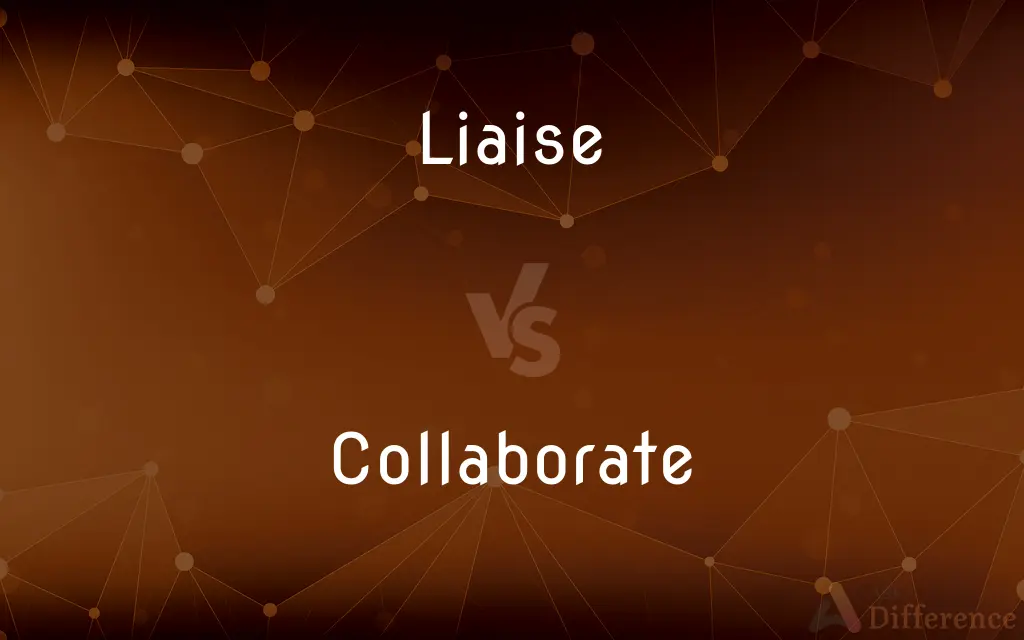Liaise vs. Collaborate — What's the Difference?
By Tayyaba Rehman & Maham Liaqat — Updated on April 9, 2024
Liaising involves establishing and maintaining communication for cooperation or coordination, whereas collaborating is working together with one or more parties to achieve a common goal.

Difference Between Liaise and Collaborate
Table of Contents
ADVERTISEMENT
Key Differences
Liaising is primarily focused on communication and coordination between parties. It involves establishing connections and ensuring that information flows smoothly between groups or individuals, often acting as a bridge to facilitate understanding or cooperation. On the other hand, collaborating goes a step further by involving joint efforts where parties actively work together, share responsibilities, and contribute resources towards achieving a shared objective.
In the context of project management, liaising might involve a project manager communicating between different departments to ensure alignment and facilitate resource sharing. In contrast, collaboration would see members of those departments working together on a task force, jointly developing solutions and sharing the workload equally. While liaising is crucial for collaboration, it serves more as a foundational step, setting the stage for the deeper engagement that collaboration entails.
Liaising often requires strong interpersonal and communication skills, as the main goal is to ensure that all parties are on the same page and that any potential issues are addressed promptly. Collaboration, however, demands these skills and a willingness to share expertise, decision-making, and creative input to innovate or solve problems collectively.
The outcomes of liaising and collaborating can also differ. Liaising aims to improve understanding, coordination, and the flow of information, which can lead to better-prepared environments for collaboration. Collaboration, by virtue of its nature, aims to produce a tangible outcome or product resulting from the combined efforts of the involved parties.
Although both liaising and collaborating are essential for successful teamwork and project management, they occupy different roles within the process. Liaising sets the groundwork for effective collaboration by ensuring clear communication and understanding, whereas collaboration is the process through which the actual joint work is carried out to achieve the common goals identified during the liaising phase.
ADVERTISEMENT
Comparison Chart
Focus
Communication and coordination.
Joint effort towards a common goal.
Key Skills
Interpersonal and communication skills.
Communication, teamwork, and problem-solving skills.
Outcome
Improved understanding and readiness for collaboration.
A tangible product or solution.
Role in Projects
Acts as a bridge for information and resources.
Involves shared responsibility in execution.
Example Activities
Setting up meetings, relaying messages.
Developing solutions, sharing workload.
Compare with Definitions
Liaise
Acting as an intermediary to facilitate cooperation.
She liaises between the software and design teams.
Collaborate
Pooling resources and efforts for a shared outcome.
The team collaborated to complete the project on time.
Liaise
Facilitating understanding and agreements.
The diplomat liaises with foreign entities to foster good relations.
Collaborate
Participating in a joint venture or partnership.
The organizations collaborate to provide community services.
Liaise
Bridging gaps between different organizational levels.
The consultant liaises between management and the workforce.
Collaborate
Engaging in creative problem-solving together.
Designers and engineers collaborate to create innovative products.
Liaise
Establish a communication link between groups.
The officer was appointed to liaise with the community.
Collaborate
Working jointly on an activity or project.
The two companies collaborate to develop new technologies.
Liaise
Ensuring coordination and information flow.
He liaised with suppliers to ensure timely delivery.
Collaborate
Sharing expertise to achieve a common goal.
Scientists from different countries collaborate on climate research.
Liaise
To effect or establish a liaison.
Collaborate
To work together, especially in a joint intellectual effort.
Liaise
To act or serve as a liaison officer.
Collaborate
To cooperate treasonably, as with an enemy occupation force in one's country.
Liaise
To establish a liaison.
Collaborate
To work together with others to achieve a common goal.
Let's collaborate on this project, and get it finished faster.
Wikipedia is a website where anyone can collaborate.
Liaise
To act between parties with a view to reconciling differences.
Collaborate
To voluntarily cooperate treasonably, as with an enemy occupation force in one's country.
If you collaborate with the occupying forces, you will be shot.
Liaise
To cooperate, consult and discuss in order to come to a common solution.
Collaborate
To work together with another toward a common goal, especially in an intellectual endeavor; as, four chemists collaborated on the synthesis of the compound; three authors collaborated in writing the book.
Liaise
To form or maintain a liaison{3}.
Collaborate
To willingly cooperate with an enemy, especially an enemy nation occupying one's own country.
Liaise
To act as a liaison{4}.
Collaborate
Work together on a common enterprise of project;
The soprano and the pianist did not get together very well
We joined forces with another research group
Liaise
Act between parties with a view to reconciling differences;
He interceded in the family dispute
He mediated a settlement
Collaborate
Cooperate as a traitor;
He collaborated with the Nazis when they occupied Paris
Common Curiosities
Can you liaise without collaborating?
Yes, you can liaise without directly collaborating, as liaising often involves facilitating communication rather than joint work.
Is collaboration possible without liaising?
Effective collaboration typically requires some form of liaising to establish clear communication and understanding among parties.
What skills are unique to liaising?
Strong interpersonal and communication skills are particularly crucial for effective liaising.
How do liaising and collaborating contribute to project success?
Liaising ensures that all parties are aligned and informed, creating a foundation for effective collaboration, which then drives the project towards its objectives through joint effort.
Can liaising lead to collaboration?
Yes, effective liaising can create the conditions necessary for successful collaboration by ensuring all parties are engaged and aligned.
How do outcomes differ between liaising and collaborating?
Liaising aims to improve coordination and understanding, while collaborating aims to produce tangible results through joint effort.
Which is more important, liaising or collaborating?
Both are important in different contexts; liaising is crucial for establishing connections and understanding, while collaborating is essential for jointly achieving goals.
How does the scale of the project affect the choice between liaising and collaborating?
Larger projects may require more extensive liaising to set up the framework for collaboration, which is then necessary to handle the project's complexity.
What is the primary difference between liaising and collaborating?
Liaising focuses on communication and coordination, while collaborating involves working together towards a shared goal.
Can you give an example of when you might only need to liaise?
When coordinating logistics for an event, you might liaise between vendors and the event planners without needing to collaborate on the actual planning.
Is one more time-consuming than the other?
Collaboration can be more time-consuming than liaising, as it involves deeper engagement and joint work towards a common goal.
How does the outcome of collaborating compare to that of liaising?
The outcome of collaborating is the actual achievement of project goals, while the outcome of liaising is more about creating a conducive environment for such achievement.
What role does technology play in liaising and collaborating?
Technology facilitates both by providing communication tools for liaising and platforms for collaborative work, regardless of geographical distance.
Can liaising and collaborating overlap?
Yes, in many projects, liaising and collaborating can occur simultaneously, with liaising continuing to ensure smooth collaboration.
How do roles differ in liaising vs. collaborating?
In liaising, roles are often focused on communication and facilitation, whereas in collaborating, roles are more about contribution towards a shared output.
Share Your Discovery
Previous Comparison
Silicone vs. Silastic
Next Comparison
Strong vs. RobustAuthor Spotlight
Written by
Tayyaba RehmanTayyaba Rehman is a distinguished writer, currently serving as a primary contributor to askdifference.com. As a researcher in semantics and etymology, Tayyaba's passion for the complexity of languages and their distinctions has found a perfect home on the platform. Tayyaba delves into the intricacies of language, distinguishing between commonly confused words and phrases, thereby providing clarity for readers worldwide.
Co-written by
Maham Liaqat















































